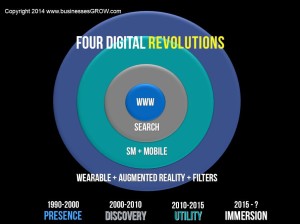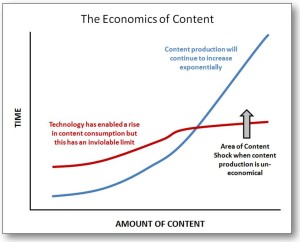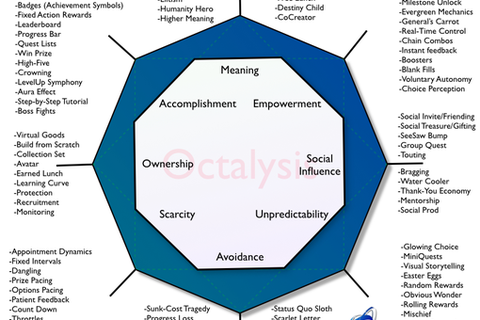When you stop to think about everything that the internet offers us on a daily basis – the answer to any question at the tip of our fingers, the ability to connect with people on the other side of the planet and to communicate with hundreds and thousands of people from the comfort of your own home – it feels as if the future is already here. All we’re missing is the hover cars.
Social media plays a big part in the innovations and abilities the internet provides. But where do we go from here? What is the future of social media?
One of my South by Southwest highlights: Mark Schaefer, author, public speaker, blogger, and marketing professor, presented what he believes the future of social media is, and how to navigate through it. More about Mark Schaefer on his blog.

Schaefer outlines the four Digital Revolutions, the three previous and the one to come. Image found here http://www.businessesgrow.com/2014/04/28/digital-marketing-innovation/
The Four Digital Revolutions
Presence (The WWW) 1990-2000 – Companies were really only expected to have a website at this point, to show an online presence.
Discovery (Search) 2000-2010 – A bigger emphasis on search engine optimization (SEO) happened in this time period, to encourage the discovery of your company.
Utility (Social Media & Mobile) 2010-2015 – The focus in this phase is on meeting the consumers’ needs when they need it, which is possible because mobile devices make it easy to consume content at anytime. The average American is spending 10 hours a day consuming content online, a two-hour increase because of mobile devices.
Immersion (User-Generated Content) 2015-? – This is where the future of social media exists. Social media sites are becoming more and more about users creating content. Schaefer estimates that by the year 2020, the amount of data online will have grown by 600% and 75% of that will be created by the consumer. This will also be the era of “wearable technology” and “immersion,” where, Schaefer says, “the Internet will surround us like the air that we breathe.” This would create a whole new landscape of marketing possibilities.
How to navigate the new social media landscape

Content Shock is created when the amount of content being produced is greater than the amount of content that people can consume. Image found on Mark Schaefer’s site http://www.businessesgrow.com/
While it’s great that everyone and her brother has access to create content online, offering a more diverse and thriving online market, this also generates stronger competition for your content to break through the clutter and be seen.
In fact, there will be a time in which the amount of content internet users can consume will be outweighed by the amount of content produced. Schaefer calls this “Content Shock” which, unfortunately, is uneconomical.
This Content Shock, which Schaefer believes is coming soon, will have some negative implications on small businesses, including:
- Big corporations will overtake the market.
- Schaefer says just like with most industries, those with “deep pockets” can obtain control over a market and even create barriers that perpetuate the Content Shock for their competitors.
- Companies will have to invest more in their content than they are getting back, making the production of content no longer worth it.
Create content that will stand out
Schaefer says that the Content Shock might be a few years off for some markets and might be here now for others. It’s important to plan ahead and think about how saturated your particular market is.
When producing content, Schaefer says to think about whether what you’re making is “RITE,” meaning:
- Relevant
- Interesting
- Timely
- Entertaining
He says that the element of fun is essential, as is serving your consumers’ needs and keeping your content human. Content that is “RITE,” especially in an under-saturated market, will get views and garner your brand attention.
Another important thing to keep in mind as the market keeps evolving is search filters, which are becoming increasingly sophisticated. Filters like Zite might soon replace Google even, making SEO less important than it used to be.
It’s essential that your brand evolves with the industry, or it will be lost in the shuffle and unable to stand up to the competition.
[social_share style=”circle” align=”horizontal” heading_align=”above” text=”How do you envision Social Media’s future? Insights from @markwschaefer at SXSWi @NewMediaChief” heading=”Be a pal … share now” facebook=”1″ twitter=”1″ google_plus=”1″ linkedin=”1″ pinterest=”1″ /]
How do you envision the future of Social Media? What are you doing to prepare your brand? Share your thoughts and insights with a quick comment.
[cta id=”4888″ align=”none”]




